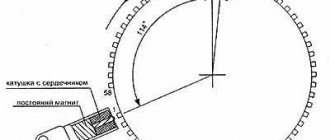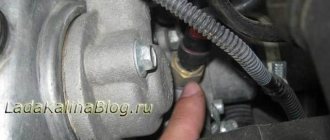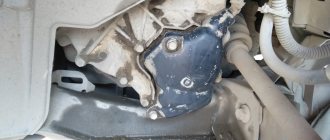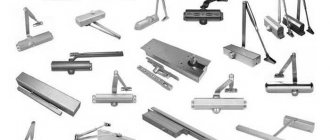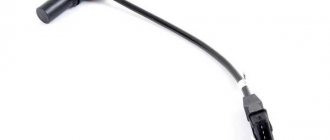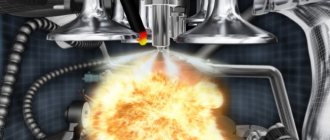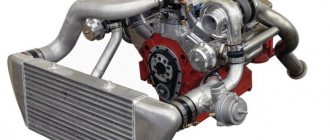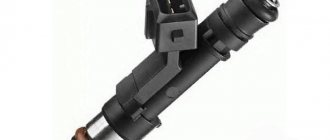How does a knock sensor work?
Car engines can use one of two types of knock sensors: resonant and broadband. But since the first type is already outdated and is rare, we will describe the operation of broadband sensors (WS).
The design of a broadband DD is based on a piezoelectric element, which, when subjected to mechanical action (that is, during an explosion, which, in essence, is detonation), supplies a current with a certain voltage to the electronic control unit. The sensor is configured to perceive sound waves in the range from 6 Hz to 15 kHz. The design of the sensor also includes a weighting agent, which enhances the mechanical effect on it by increasing the force, that is, it increases the sound amplitude.
The voltage supplied by the sensor to the ECU through the connector terminals is processed electronically and then a conclusion is made whether there is detonation in the engine, and accordingly, whether the ignition timing needs to be adjusted, which will help eliminate it. That is, the sensor in this case is only a “microphone”.
Characteristics and features of replacing regulators
Replacing regulators on a Mazda three can be done both at home and at a service station. Since this, in principle, is nothing complicated, let’s consider the process of replacing basic devices at home.
Detonation
The detonation controller in these cars is mounted behind the intake manifold, on the BC. It is designed to transmit pulses, on the basis of which the ECU automatically changes the ignition timing. In this case, the angle must be such that there is no detonation during engine operation. In the event that an element breaks, the corresponding light on the device should light up. Since detonation during engine operation has a detrimental effect on the condition of the power unit as a whole, the device should be replaced immediately after symptoms of a malfunction are detected.
Signs of a malfunctioning knock sensor
If the DD fails completely or partially, a malfunction of the knock sensor manifests itself according to one of the symptoms:
- Engine shaking . If the sensor and control system in the engine are working properly, this phenomenon should not occur. By ear, the appearance of detonation can be indirectly determined by the metallic sound emanating from a running engine (knock of fingers). And excessive shaking and jerking during engine operation is the first way to determine a malfunction of the knock sensor.
- Reduced power or “dullness” of the engine, which is manifested by deterioration of acceleration or excessive increase in speed at low speeds. This happens when, with an incorrect DD signal, the ignition angle is spontaneously adjusted.
- Difficulty starting the engine , especially “cold”, that is, at low temperatures after a long period of inactivity (for example, in the morning). Although it is quite possible for the car to behave this way even at warm ambient temperatures.
- Increased fuel consumption . Since the ignition angle is disturbed, the air-fuel mixture does not meet optimal parameters. Accordingly, a situation arises when the engine consumes more gasoline than it needs.
- Fixing knock sensor errors. Usually the reasons for their appearance are the signal from the sensor going beyond the permissible limits, a break in its wiring, or a complete failure of the sensor. The occurrence of errors will be indicated by the Check Engine light on the dashboard.
However, it is worth considering that such symptoms may indicate other engine failures, including other sensors. It is recommended to additionally read the ECU memory for errors that could arise due to incorrect operation of individual sensors.
Knock Sensor Circuit Malfunctions
In order to identify DD faults more accurately, it is advisable to use electronic error scanners for the electronic control unit. Especially if the check indicator light on the dashboard lights up.
Often, error p0325 “Open in the knock sensor circuit” indicates problems in the wiring. This could be a broken wire or, more often, oxidized contacts. It is necessary to perform preventative maintenance on the connectors on the sensor. Sometimes error p0325 occurs because the timing belt slips by 1-2 teeth.
Error P0328 “Knock Sensor High” often indicates a problem with high-voltage wires. In particular, if the insulation on them or the piezoelectric element breaks through. Similarly, this error can also occur due to the fact that the timing belt has jumped a couple of teeth. To diagnose, you need to check the marks on it and the condition of the washers.
Errors p0327 or p0326 are usually formed in the ECU memory due to a low signal from the knock sensor. The reason may be poor contact from it, or weak mechanical contact of the sensor with the cylinder block. To eliminate the error, you can try treating both the mentioned contacts and the sensor itself with WD-40. It is also important to check the sensor mounting torque, as this parameter is critical to its operation.
In general, it can be noted that the symptoms of a malfunction of the knock sensor are very similar to the symptoms characteristic of late ignition because the ECU, for the sake of safety for the engine, tries to automatically do it as late as possible, since this prevents destruction of the engine (if the angle is too early, then in addition detonation occurs, not only does the power drop, but there is also a risk of valve burnout). So, in general, we can conclude that the main symptoms are exactly the same as with incorrect setting of the ignition timing.
SIGNS OF BREAKAGE
During normal engine operation, the knock sensor does not produce danger signals and does not participate in the operation of the control system in any way. The ECU program performs all actions according to its data cards hardwired into memory; standard modes ensure knock-free combustion of the air-fuel mixture.
But with significant temperature deviations in the combustion chambers, detonation may occur. The task of the DD is to give a signal in time to parry the danger. If this does not happen, then characteristic sounds are heard from under the hood, which for some reason drivers call finger tapping.
Although in fact no fingers are knocking, and the main level of volume comes from the vibration of the piston bottom, which is hit by a wave of explosive combustion. This is the main sign of abnormal operation of the knock control subsystem.
Indirect signs will be a noticeable loss of engine power, an increase in its temperature, up to the appearance of glow ignition, and the inability of the ECU to cope with the situation in normal mode. The reaction of the control program in such cases will be to light up the “Check Engine” light.
Typically, the ECU directly monitors the activity of the knock sensor. Its signal levels are known and stored in memory. The system compares the current information with the tolerance range and, when deviations are detected, simultaneously with the display turning on, it remembers error codes.
If you determine the breakdown yourself, then it’s not far to independently diagnose the sensor, as well as replace it yourself. In principle, this is not difficult, but it requires some understanding of the process.
- The engine is tripping;
- Dynamics deteriorates, poor acceleration;
- When starting off and when moving downhill, the “Check Engine” lights up;
- During acceleration, the “Check Engine” light comes on;
- The computer displays a knock sensor error.
The knock sensor of the VAZ 2114 is a device on the serviceability of which the overall performance of the engine of the fourteenth depends. If the sensor fails, you will notice the following changes in the operation of the car:
- The engine will start to stall at idle;
- Acceleration dynamics will worsen;
- Gasoline consumption will increase;
- At the time of acceleration and when moving off the car, the “Check Engine” indicator will light up on the dashboard.
Also, if the DD is faulty, errors 0327/0326, 0328 or 0325 begin to appear on the on-board computer of the fourteenth.
Error No. 0325 indicates problems with the wiring supplying power to the sensor; it may break or become oxidized. Actual wire breakage is usually quite rare, so in most cases the problem is oxidation of the contacts.
In addition to a failed DD, error 0325 may indicate a slipped timing belt, so if cleaning the contacts does not work, check the belt.
Errors 0326 and 0327 occur when the brain of the car (ECU) with the DD receives an insufficient power signal. Here, again, the problem may be either in the device itself or in the contacts. It is also possible that the cause of the low signal is poor tightening of the DD in the mounting socket.
Check how tight the DD is
Causes of knock sensor malfunction
As for the reasons why problems arise with the knock sensor, these include the following breakdowns:
- Loss of mechanical contact between the sensor housing and the engine block . As practice shows, this is the most common reason. Typically, the sensor itself has a round shape with a mounting hole in the middle, through which it is attached to its seat using a bolt or pin. Accordingly, if the tightening torque in a threaded connection decreases (the pressing of the motor to the engine is weakened), then subsequently the sensor does not receive sound mechanical vibrations from the cylinder block. In order to eliminate such a breakdown, it is enough to tighten the mentioned threaded connection, or replace the mounting bolt with a mounting pin, since it is more reliable and provides a tight mechanical connection.
- Sensor wiring problems . In this case, there may be various problems, for example, a short circuit of the supply or signal wire to ground, mechanical damage to the wire (especially in places where it is bent), damage to the internal or external insulation, breakage of the entire wire or its individual wires (supply, signal), violation of the shielding braid. In this case, the problem is solved by restoring or replacing its wiring.
- Poor contact at the connection point . This situation sometimes happens if, for example, the plastic latch at the point where the sensor contacts are connected is broken. Sometimes, as a result of shaking, the contact is simply broken, and accordingly, the signal from the sensor or the power to it simply does not reach the recipient. To repair, you can try replacing the chip, correcting the contact, or using another mechanical method to try connecting two pads to the contacts.
- Complete sensor failure . The knock sensor itself is a fairly simple device, so there is nothing special to break there, and accordingly, it rarely fails, but it does happen. The sensor cannot be repaired, so in case of complete breakdown it is necessary to replace it with a new one.
- Problems with the electronic control unit . In the ECU, like any other electronic device, software failures can occur, which leads to incorrect perception of information from the DD, and accordingly, the unit makes incorrect decisions.
It is interesting that when a car owner contacts a car service center with complaints about the operation of the knock sensor, some unscrupulous repairmen immediately offer to replace it with a new one. Accordingly, take more money from the client. Instead, you can try tightening the torque on the sensor threaded mount and/or replacing the bolt with a stud. In many cases this helps.
What are the effects of knock sensor malfunctions?
Is it possible to drive with a faulty knock sensor? This question interests motorists who are encountering this problem for the first time. In general terms, the answer to this question can be formulated as follows: in the short term, you can use the car, but at the earliest possible opportunity, it is necessary to carry out appropriate diagnostics and fix the problem.
Indeed, according to the principle of operation of the ECU, when a malfunction of the fuel knock sensor occurs, a late ignition is automatically set to prevent damage to the piston group parts if real detonation occurs during combustion of the fuel mixture. As a result, fuel consumption rises and dynamics drop significantly, which will become especially noticeable as the speed increases.
What happens if you turn off the knock sensor completely?
Some car owners even try to disable the knock sensor because under normal operating conditions and refueling with good fuel it may seem unnecessary. However, it is not! Because detonation occurs not only due to poor fuel and problems with spark plugs, compression and misfires. Therefore, if you disable the knock sensor, the consequences may be as follows:
- rapid failure (breakdown) of the cylinder head gasket with all the ensuing consequences;
- accelerated wear of elements of the cylinder-piston group;
- cylinder head crack;
- burnout (full or partial) of one or more pistons;
- failure of the jumpers between the rings;
- connecting rod bend;
- burning of valve plates.
This is due to the fact that if this phenomenon occurs, the electronic control unit will not take measures to eliminate it. Therefore, in no case should you turn it off and install a jumper from the resistance, because this is fraught with expensive repairs.
Replacement
p, blockquote 50,0,0,0,0 –>
If there is a suspicion that the knock sensor is faulty, it should be replaced. In general, they very rarely fail and have a long service life, often exceeding the service life of the engine. In most cases, a malfunction occurs as a consequence of an accident or dismantling of the power unit during a major overhaul.
p, blockquote 51,0,0,0,0 –>
The operating principle of knock sensors is the same for each type (resonant and broadband). Therefore, sometimes you can use a device from other engine models if the original one is not available. Of course, if it fits the fitting data and connector. It is allowed to install a used DD from disassembly.
p, blockquote 52,0,0,0,0 –>
How to determine if a knock sensor is faulty
When the first signs of DD failure appear, a logical question is of interest - how to check and determine the malfunction of the knock sensor. First of all, it must be said that checking the knock sensor is possible without removing it from the cylinder block, or after removing it from its seat. Moreover, first it is better to do several tests when the sensor is screwed to the block. Briefly the procedure looks like this:
- set the idle speed to approximately 2000 rpm;
- With some metal object (small hammer, wrench), apply one or two gentle blows (!!!) to the cylinder block body in the immediate vicinity of the sensor (you can lightly hit the sensor directly);
- if the engine speed drops after this (this will be audible), it means the sensor is working;
- The speed remains at the same level - an additional check needs to be performed.
To check the knock sensor, a car enthusiast will need an electronic multimeter capable of measuring the value of electrical resistance, as well as DC voltage. The best way to check is with an oscilloscope. A diagram of the sensor operation taken with its help will clearly show whether it is operational or not.
But since only a tester is available to the average car enthusiast, it is enough to check the resistance readings given by the sensor when tapped. The range of resistance changes is within 400 ... 1000 Ohms. It is also imperative to carry out a basic check of the integrity of its wiring - whether there is a break, damage to the insulation or short circuit. You also cannot do this without the help of a multimeter.
If the check shows that the fuel knock sensor is working properly, but the error indicates that the sensor signal is outside the permissible range, then perhaps it is worth looking for the cause not in the sensor itself, but in the operation of the engine or gearbox. Why? Sounds and vibration are to blame for everything, which the engine can perceive as fuel detonation and incorrectly adjust the ignition angle!
Device diagnostics
To be sure that the 2110/2112 knock sensor is faulty, it is worth checking it. This is done with a multimeter.
After all, you should understand that not in all cases the knock sensor will need to be replaced. In some cases, cleaning it will help. Sometimes other faults are detected that do not relate to the device itself. For example, an open circuit (network break). But in this case, the working connection diagram is subject to diagnosis.
If you don’t know how to check the device, then just follow the steps presented:
- Turn on the multimeter.
- Connect the wires to the two contacts of the broadband sensor. But there is a small note here: if we are talking about the resonant type, then the negative wire must be closed on the body, but the positive wire is in the center of the sensor.
- Take a screwdriver or any other metal object and start making small impacts on the sensor. But we’ll look at what this affects a little lower.
The thing is that, based on the force of the blows applied, the values on the measuring device will gradually change. They should fluctuate between 40–200 mV. This is the norm, which corresponds to the fact that the device is in good condition. But any serious damage to it will be reflected on the multimeter screen as a zero value.
Note that checking the knock sensor does not end there. Now you will need to identify the cause of the problem. Moreover, you need to look for it in the wires. In some cases, you may only need to replace the pad. The thing is that it is the one that is most exposed to the environment, which leads to corrosion on the contacts.
If you are interested in the question of how to diagnose an 8-valve injector, then you should note that in this case the process is more labor-intensive. The thing is that sometimes you need to spend extra time to remove it.
You will need:
- Dismantle the device.
- Set the multimeter to measure the applied voltage at about 200 mV.
- Place one probe on the connector of the device, and the second on the opposite connector.
- Start tapping with a screwdriver, as you did in the previous case. But focus your attention on the force of the blow, since the stronger it is, the higher the signal level should be.
- Finally, check the resistance of the piezoelectric element.
In general, the VAZ 2110 8-valve injector sensor breaks down extremely rarely. The most common reason for the absence of a signal on the ECU is a break in the connection circuit.
If this device is seriously damaged, you should consider purchasing a new one. But you definitely need to familiarize yourself with how to replace the knock sensor, because installing it incorrectly can lead to the problem not being resolved.
Signs of a faulty knock sensor VAZ 2114
Signs of a malfunction of the VAZ 2110 knock sensor. Something always breaks in a VAZ. If the car owner knows the signs of a malfunction of the VAZ 2110 knock sensor (and, of course, other controllers) and knows how to read the errors shown by the ECU, this can make his life much easier. Not a single sensor is built into the car just like that; each one is designed by the designers to maintain and check the normal operation of various components.
From this point of view, the device that displays the level of detonation is particularly noteworthy. As long as the engine is running normally and no explosions occur, the engine can be said to be asleep. The car control system uses tabular, optimal parameters, giving instructions to the motor. However, if detonation occurs, the sensor instantly measures its strength, transmits the data to the on-board computer, and it reduces the advance angle. The correction occurs until the joint efforts of the motor control unit and the ECU stop the detonation, after which the sensor again seems to hide and fall asleep.
Thanks to such actions, all the troubles and dangers that arise from a detonating fuel-air mixture are prevented. And there are not so few of them, and they can sometimes cause significant damage to the engine unit in particular and the car as a whole. Signs of a malfunction of the VAZ 2110 knock sensor will help its owner understand what is happening with his car and take appropriate measures in a timely manner. About what visual points you should pay attention to, first of all, in order to detect a DD malfunction in time, and how to prevent it.
What you can notice first The knock sensor itself is quite reliable and does not fail very often. However, its performance should be checked in case of uncharacteristic behavior of the engine: a clear drop in engine power; “dullness” of the engine, increased speed at low speeds; deterioration of car acceleration; increased fuel consumption. It can reach +10%; smokier than usual exhaust. Tapping fingers and sudden jerks in movement may also be observed, but these are more individual reactions. Additional check Regarding electronic warnings.
Unfortunately, the control system often makes mistakes. So before trusting her information, it is worth conducting additional verification. Code 34 indicates failure of the DD. However, to make sure of this, you need to reset the self-diagnosis results, make a circle a couple of kilometers around the house and look at the readings again. If there is no error signal, it means that either the on-board computer was mistaken, or the sensor operates intermittently due to loose or oxidized contacts. Code 325 reports a broken DD. But often the unit records malfunctions of the throttle position sensor in its memory under these numbers. To check the assumption, you need to go into the menu and look at the voltage data on the suspected sensor: if the TPS is acting up, it will jump, while the detonation readings remain normal.
Searching for the cause As already mentioned, the DD is a surprisingly robust device. In most cases, it is enough to look for an open circuit, and first check the terminals. The wires ring if the self-diagnosis does not light up immediately, but when the engine spins above 3000 rpm. If the electrics are in order, the knock sensor itself is checked. It is located on the left in the direction of travel, where the air filter is located.
It is difficult to get to it, since the sensor is located between the cylinders - this allows it to take readings from the entire block. The sensor is dismantled. To do this, you will need a 13 socket key if your machine has a single-pin DD, and a 22 socket if it has a two-pin one.
Take a voltmeter with good sensitivity and set it to a mode of up to 200 MV. If there are 2 contacts, the sensor connectors are connected to the device. On another type of sensor, one probe is thrown onto the contact, the second – onto the body. Using a screwdriver, bolt or heavy pen, tap the body with varying strength (but without zeal). The voltmeter readings should fluctuate: the more noticeable the shock, the larger the jump.
If the device does not respond to influences, you need to change the sensor. Sometimes people try to save money on it by buying a used one, but this is not worth doing: a new one costs 200-300 rubles, which can be considered quite affordable, and a used one may be in even worse condition than a removed one. If all checks have been carried out and even the DD has been replaced, but signs of a malfunction of the VAZ 2110 knock sensor remain, then the problem is not at all with it.
Detonation is caused by other factors, among which the first place is gasoline poured in an untested place. However, other factors may also have an effect: compression problems, flooded or burnt-out spark plugs, etc. If you are confident in the integrity of the knock sensor, you will have to dig much deeper into the insides of the car.
OPERATING PRINCIPLE AND FUNCTIONAL PURPOSE
There is a "Check" icon on the car's dashboard. In English this translates as check or control. If it is not active, then the knock sensor is working and working as expected.
The operating principle of the knock sensor is based on a piezoelectric mechanism. Inside the sensor there is a plate with a piezo effect. When detonation occurs, voltage is created at the input and output, and the engine vibrates. Otherwise, this is called the creation of a potential difference. If the voltage level at one end is too high, the sensor corrects this process.
If for any reason the sensor breaks down, the “Check” icon will light up on the dashboard. This will mean only one thing: urgent repair or replacement of the element is required.
If the electrical circuit of the sensor is not broken, but a breakdown exists, the “Check” icon will not light up. Therefore, it is worth listening to your car sometimes.
Let's figure out what a knock sensor is used for using its typical operating cycle as an example.
When the engine is operating in normal mode, the DD, roughly speaking, sleeps. However, when detonation begins to occur inside the cylinder block, the sensor reacts to its power and sends a corresponding signal to the ECU. Based on the information received, the controller changes the ignition angle until detonation in the fuel combustion chambers disappears.
What does the knock sensor of the VAZ 2114 affect? Without it, the electronics of the fourteenth cannot set the correct ignition timing, which threatens engine malfunctions: if the timing is smaller than necessary, as a result of micro-explosions, the engine will not be able to produce its usual power, and the valves in the cylinders will wear out quickly. More than necessary - gasoline consumption will increase, acceleration dynamics will decrease, and the engine itself will constantly overheat.
The operating principle of the knock sensor is based on piezoelectric effect technology. Inside the metal body of the device there is a plate that is highly sensitive to the force of mechanical influences exerted on it.
The device is the simplest
When detonation occurs in the engine, vibration is transmitted to the plate, which is converted by the sensor from mechanical energy to alternating current. The power of the generated current depends on the strength of the shock applied to the sensor.
There are two types of DD installed on the VAZ 2114 - broadband and resonant.
- The VAZ resonant knock sensor has a cylindrical shape. It is sensitive only to micro-explosions whose power is above a certain level;
- Broadband devices, on the contrary, are sensitive to all vibrations occurring in the engine, information about which they transmit to the ECU, and the electronics, based on the magnitude of the received alternating voltage, themselves determine whether detonation has occurred in the engine.
Resonant and broadband devices are not interchangeable, so if replacement is necessary, carefully select a new DD.
The cost of a new DD varies from 250 to 700 rubles for sensors of any type. We do not recommend taking domestically produced devices, since reviews from owners of fourteenth devices indicate that they have an extremely low working life. Moreover, under the guise of DD, ordinary dummies in an identical body, but without any functional filling, are often sold.
The best option is sensors produced by the German company Bosch; they cost almost 2 times more than the original VAZ ones, but at the same time they last much longer and work without problems. Also on the fourteenth you can install a VAZ 2115 knock sensor and devices for GAZ cars (article 18.3855), their mounting sockets are completely similar.
Knock sensor VAZ 2114 bosch
Where is the knock sensor on a VAZ 2114
I’ll start today’s article with a story about what a knock sensor (DS) is and why a car engine needs it. This sensor is necessary, as the name implies, in order to monitor detonation in the engine, as well as knocking noises that indicate malfunctions.
Each knock causes the sensor to produce a pulse with a certain voltage. After this, the pulse goes to the controller, which performs subsequent processing. The controller adjusts the ignition timing depending on the size of the received impulse; the whole process takes a few fractions of seconds, so most often we simply cannot feel anything.
DD belongs to that category of automotive sensors that fail very rarely, for which a HUGE driver’s THANK YOU to him and his creators!
Where is the knock sensor located?
The VAZ 2114-2115 knock sensor is located between the second and third cylinders on the engine block; it can be one- or two-contact.
Operating principle
The operation of the sensor is based on the use of the piezoelectric effect. As a result of detonation, and therefore vibration with a certain frequency, voltage appears at the tips of the piezoelectric plate, which is the main component of the device.
As the frequency and amplitude of the oscillations increase, the voltage increases; when a certain level is reached, the control electronic unit comes into operation, reducing the ignition timing in the ignition system and automatically eliminating the reasons that may cause the detonation effect. As a result of the interaction between the sensor and the control unit, optimal engine operating characteristics are achieved.
As it becomes clear, if the sensor fails, the process of adjusting the advance angle becomes impossible and although the engine does not stop working, the fuel mixture in it at a certain point in time may begin to detonate. In this regard, the part should be replaced and this should not be delayed for long.
To your attention errors in the knock sensor VAZ 2114
- Error code 0325 - there is a break in the wiring that supplies power to the DD. Most often, the cause of this error is oxidized contacts of the knock sensor; a wiring break occurs extremely rarely. It is necessary to clean the contacts, this will give a positive result, at least it will not get worse. In addition, this error can be caused by the timing belt, so if after cleaning the DD contacts the problem remains, check the timing belt, most likely it has jumped a couple of teeth. Align the belt to the marks and check again if the error appears.
- Error code 0328 - as a rule, indicates faulty high-voltage wires. However, the possibility of the timing belt jumping cannot be ruled out.
- Error code 0326 , as well as 0327 , mean an excessively weak (low) signal from the knock sensor. To eliminate errors, it is necessary to clean the VAZ 2114 DD connection contacts. The tightening torque of the sensor is also important; if the tightening is weak, the above errors may appear.
How to check the knock sensor of a VAZ 2114-2115
- Prepare the end face at “13” or “22” (depending on the type of sensor).
- Multimeter or voltmeter.
- Screwdriver.
Sequencing:
- Remove the sensor from the engine block.
- Turn on the voltmeter or multimeter in operating mode with a limit of 200 mV.
- Connect the multimeter electrodes to the knock sensor terminals, then use a screwdriver to tap the part body.
- While tapping, observe the changes on the device display; depending on the strength of the blows and frequency, the voltmeter readings should change. If your knock sensor readings do not change, it is faulty and needs to be replaced.
VAZ knock sensors come in two types:
- Resonant (made in the shape of a barrel).
- Broadband (made in tablet form).
These sensors are completely different, so before you buy a knock sensor for a VAZ 2114 or 2115, check which one you have installed.
An easy way to diagnose
After removal, connect the voltmeter with the negative terminal to the sensor body, and the positive terminal to the wire coming from it. The voltmeter measurement limit should be set to 0.2 V. Now take into account the principle of operation of the knock sensor. It was said above that the plate begins to generate electricity during an impact.
If they do not change, the device is damaged. In this case, only a complete replacement will help. You can purchase the sensor at any auto store. Please note that there are several designs for this device. Therefore, take the old sensor with you as a reference.
The service life of knock sensors is very long. They are practically eternal, since there is simply nothing to break in them. It is also worth noting that different cars use the original knock sensor. The symptoms of a malfunction (it doesn’t matter whether it’s a Toyota or a VAZ) will be the same, but the level and shape of the output signal may differ significantly.
We find the sensor installation location, usually this is the central part of the engine block, between the second and third cylinders, but it is better to check the type of sensor, its markings and internal resistance in the car’s operating manual. The mount is easy to see by the wire with the connector.
First, unscrew the 22 mm or 13 mm nut on the stud, depending on the version of the sensor, carefully disconnect and remove the electrical connector, and remove the sensor “donut” from the mounting stud. We have two contacts available for testing - ground and signal wire.
We remember that inside the “donut” there is a piezoelectric crystal, even taking into account the presence of special compensators in the design, it remains sensitive to impacts and falls on the concrete floor. Also, do not disassemble the sensor. If the integrity of the housing is compromised, this is also a sign of a possible malfunction.
To check the functionality of the sensor, you must use a multimeter with a measurement range of thousandths of a volt. Try not to use old or twisted conductors as test leads. Their own resistance may not match the device.
Carefully, with a little force, “click” a metal object against the central metal part of the sensor. At the terminals of a working sensor, the multimeter will show a jump in electrical potential of 40-150 mV. A faulty device will not produce potential surges.
One of the signs of “problematic health” will be a lack of resistance or very high internal resistance. In order to check the presence of an internal contact in the circuit, we measure the resistance value between the terminals and compare it with the characteristic specified in the description.
DETAILS: Trouble P0157 - Oxygen Sensor Circuit Low Voltage
The appearance of a sign of mild detonation will confirm the symptom; the old knock sensor did not work in the circuit. Additionally, you can install the problematic sensor on another engine and check for detonation when you sharply press the gas pedal. As a result, you need to compare the signs of operation of a working and faulty sensor. If symptoms also appear on the second motor, then the sensor must be permanently replaced.
You can replace the sensor with a similar model, only if the catalog number matches. This requirement is mandatory to ensure correct and safe operation of the ECU. But there is a danger of getting into trouble if it is a counterfeit product of the Chinese automobile industry; it is difficult to say by what criteria its suitability can be confirmed.
Why do you need a knock sensor on a VAZ 2114?
The operation of the VAZ 2114 power unit may be accompanied by the appearance of detonation. It has a bad effect on the engine, creating parasitic vibration and having a destructive effect on the main elements of the internal combustion engine.
Damage and metal fatigue gradually accumulate in the engine, which results in the imminent need for major engine repairs. A combination of electronic control units and DD is working to eliminate detonation. The meter detects the occurrence of non-optimal ignition of the fuel-air mixture, and the main module corrects the spark advance angle.
Purpose of the knock sensor
Early VAZ 2114 models used a resonant knock sensor. Subsequently it was replaced by broadband. Both DDs have a similar principle of operation, but differ significantly in design. Therefore, they are absolutely non-interchangeable.
The broadband DD is made in the shape of a round torus. It is attached to the engine with a bolt passing through a hole located in the center. There is a two-pin connector on the side of the torus for connection to the main module.
Fixing the resonant knock sensor does not require the use of a bolt. On one side of its body there is a thread with which it is screwed into a seat on the cylinder block.
A piezoelectric element is located inside both types of DD. It is sensitive to vibration and shock. The difference between the resonant DD is its narrower control range.
An electrical signal of a certain frequency and amplitude is generated inside the knock sensor. It goes to the ECU. The electronic control module monitors and analyzes the received signal. When detonation is detected, the ECU adjusts engine operation according to the established algorithm.
Eliminating detonation minimizes parasitic loads on the engine. As a result, the engine resource increases. This is what the knock sensor affects.
What is detonation?
This issue should also not be ignored. After all, in order to study the entire process of the sensor, you need to know what it measures. On modern cars that have such devices in their circuitry, external signs of detonation may not be noticed. But they are clearly visible on early models that used carburetors. Fingers pounding is the first sign that can be felt. The reason for this sound lies in the fuel system and ignition.
The combustion process is destabilized, and the ignition timing remains at the same level. This is the root cause. The result is that small explosions occur in the combustion chambers of all engine cylinders. Gasoline mixed with air ignites on its own, and the blast wave hits the walls of the combustion chamber with force. From the outside you can’t even tell that this is a micro-explosion. When the engine is running, it sounds more like a metallic knock, as if someone is hitting an anvil with a hammer.
Location of the knock sensor on the VAZ 2114
The location where the DD is located is selected in such a way that the sensor has the greatest sensitivity. Therefore, the DD is mounted directly on the cylinder block. You can find the location by tracing the wires coming from the electronic engine control unit. It is easier to do this on a VAZ 2114 with an 8-valve engine, since its engine compartment layout is less loaded. On a car with 16 valves, it is more difficult to determine what each loop and sensor is responsible for.
Replacing the device
It should be clear that the connection of a new detonation device VAZ 2110 8 valves or 2112 16 valves is carried out after dismantling the old one. This process will not take much time. The only thing to keep in mind is that you will need a torque wrench.
Installation sequence:
- Turn off the ignition if necessary.
- Remove the wiring block.
- Unscrew and remove the old device. It is unscrewed with different keys depending on the type of device itself. For broadband you will need the thirteenth key, and for resonant - the twenty-second.
- Install a new device.
- Start tightening the nut from 10 to 23 Nm.
If you did everything correctly, your engine will operate stably, and the ECU will receive signals in a timely manner.
Remember that only when you have checked the device with a multimeter and you can completely verify that it is faulty can you replace it. This will allow you to save not only money, but also the time that you will have to spend on replacing and installing a new device.
Sensor cost
On VAZ 2114 cars of early production years there is a Lada sensor 21120385501001. It has an extremely low prevalence and because of this its price is high and amounts to 800-1300 rubles. The only commonly found analogue is General Motors 21120-3855010-01 with a cost of 1600-1800 rubles.
The original broadband DD has article number 21123855020. Its price is much lower and amounts to 100-160 rubles. Its good analogues are presented in the table.
Table - Good analogues of the original VAZ 2114 knock sensor
| Manufacturer | vendor code | Approximate cost, ruble |
| Fenox | SD10100O7 | 210-420 |
| Decaro | 2112-3855020 | 360-490 |
| Samara 2112 | 3855020 | 200-250 |
| Road map | 21123855020 | 260-380 |
| ERA | 550489 | 300-340 |
Methods for checking a knock sensor
If signs of malfunction of the DD appear, then you should check for errors. About problems with the knock sensor they say:
- code 0326, indicating the signal level is too high;
- code 0327, indicating a low signal level, for example, due to the fact that the tightening torque does not correspond to the nominal one;
- code 0325, there is an open circuit in the circuit
You can check the DD by measuring the resistance.
You can check the DD with a multimeter. To do this, check the presence of voltage at the sensor outputs when tapping it with a metal rod.
Can the device fail?
Like any other part, this device may stop sending a signal to the ECU.
This may indicate a temporary failure or complete failure of the device. This can happen due to:
- the presence of large corrosive formations;
- wiring violations (this indicates an open circuit);
- serious malfunctions that occurred due to the device being broken;
- incorrect replacement of the device itself.
But are there any signs of trouble? Undoubtedly. A breakdown may be indicated by uncharacteristic engine behavior, which manifests itself in:
- a clear drop in engine power;
- a sharp increase in speed at low speeds;
- significant deterioration in car acceleration performance;
- increased consumption of fuel fluid.
All these symptoms indicate that something is wrong with the device. But before you think about buying a new device, you should diagnose the old one. To do this, you need to know how to check the knock sensor, as well as where it is located. Let's focus on the last one for now.
Self-replacement of sensor 21120385501001 on a VAZ 2114
Replacing the resonant DD is carried out according to the instructions below.
- .De-energize the on-board network.
- Remove contact with DD.
- Unscrew the sensor.
- Dismantle the DD.
- Install the new one in reverse order.
Replacing broadband DD on VAZ 2114
The broadband DD is replaced according to the algorithm below.
- Disconnect the terminal and unscrew the sensor.
- Remove DD.
- Install the new wideband sensor in reverse order.
